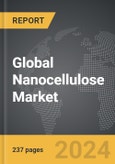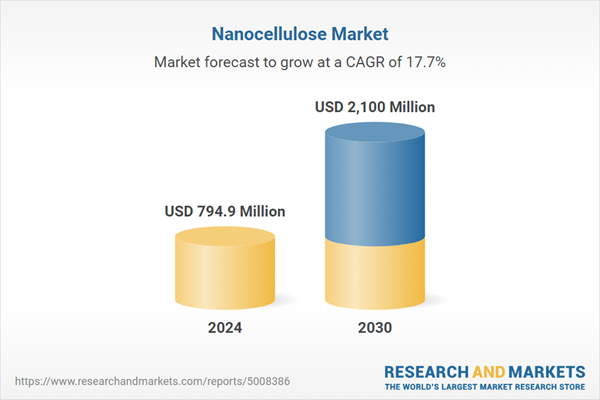The global market for Nanocellulose was valued at US$794.9 Million in 2024 and is projected to reach US$2.1 Billion by 2030, growing at a CAGR of 17.7% from 2024 to 2030. This comprehensive report provides an in-depth analysis of market trends, drivers, and forecasts, helping you make informed business decisions. The report includes the most recent global tariff developments and how they impact the Nanocellulose market.
The commercial interest in nanocellulose is driven by its eco-friendly nature and functional superiority over many synthetic materials. For instance, in the paper and packaging industry, nanocellulose enhances barrier properties which can significantly improve food packaging by making it more resistant to oil, air, and water. In the realm of materials science, nanocellulose composites are being developed for use in everything from car bodies to airplane components because they offer a remarkable strength-to-weight ratio which is critical for enhancing energy efficiency. Moreover, the electronics industry sees nanocellulose as a game-changing material for the development of next-generation devices, including flexible screens and solar panels. Another compelling aspect of nanocellulose is its role in sustainability; as a biodegradable material produced from renewable resources, it aligns well with the growing global commitment to reducing environmental footprints and enhancing the circular economy.
The growth in the nanocellulose market is driven by several factors, including advancements in sustainable manufacturing processes, the increasing applicability in high-performance products, and shifting consumer preferences towards environmentally friendly products. Technological innovations that enable cost-effective and scalable production of nanocellulose are key to its expanded use across various industries. Additionally, regulatory incentives for green materials are prompting companies to invest in nanocellulose as a strategic move to enhance environmental compliance and marketability. Consumer behavior is increasingly favoring products that combine sustainability with advanced functionality, which positions nanocellulose favorably as a material that meets these criteria. Moreover, as industries such as automotive, aerospace, and electronics continually seek materials that can provide new levels of performance while reducing environmental impact, nanocellulose stands out as a highly attractive option. These drivers are expected to propel the continued expansion and diversification of the nanocellulose market, solidifying its status as a cornerstone material in the future of both green chemistry and advanced material science.
Segments: Product Segment (MFC & NFC, Nanocrystalline Cellulose, Other Product Segments); Application (Composites & Packaging, Paper & Pulp, Paints & Coatings, Oil & Gas, Personal Care, Other Applications).
Geographic Regions/Countries: World; USA; Canada; Japan; China; Europe; France; Germany; Italy; UK; Rest of Europe; Asia-Pacific; Rest of World.
The analysts continuously track trade developments worldwide, drawing insights from leading global economists and over 200 industry and policy institutions, including think tanks, trade organizations, and national economic advisory bodies. This intelligence is integrated into forecasting models to provide timely, data-driven analysis of emerging risks and opportunities.
Global Nanocellulose Market - Key Trends & Drivers Summarized
Nanocellulose is an advanced material derived from cellulose, the most abundant organic polymer on Earth. This nanomaterial is distinguished by its impressive strength, lightweight, and biodegradable properties, making it a promising substitute for a variety of synthetic materials. Structurally, nanocellulose is characterized by its nanoscale fibers or crystals that can be isolated from wood fibers and other plant matter using high-intensity mechanical or chemical processes. The unique qualities of nanocellulose include a high surface area, significant mechanical strength, and the ability to form transparent films, which are highly valuable in industries such as packaging, composites, and electronics. Its potential applications are vast, ranging from more durable yet lightweight automotive components to flexible electronics and medical devices, including wound dressings that promote healing due to their biocompatibility and moisture retention capabilities.The commercial interest in nanocellulose is driven by its eco-friendly nature and functional superiority over many synthetic materials. For instance, in the paper and packaging industry, nanocellulose enhances barrier properties which can significantly improve food packaging by making it more resistant to oil, air, and water. In the realm of materials science, nanocellulose composites are being developed for use in everything from car bodies to airplane components because they offer a remarkable strength-to-weight ratio which is critical for enhancing energy efficiency. Moreover, the electronics industry sees nanocellulose as a game-changing material for the development of next-generation devices, including flexible screens and solar panels. Another compelling aspect of nanocellulose is its role in sustainability; as a biodegradable material produced from renewable resources, it aligns well with the growing global commitment to reducing environmental footprints and enhancing the circular economy.
The growth in the nanocellulose market is driven by several factors, including advancements in sustainable manufacturing processes, the increasing applicability in high-performance products, and shifting consumer preferences towards environmentally friendly products. Technological innovations that enable cost-effective and scalable production of nanocellulose are key to its expanded use across various industries. Additionally, regulatory incentives for green materials are prompting companies to invest in nanocellulose as a strategic move to enhance environmental compliance and marketability. Consumer behavior is increasingly favoring products that combine sustainability with advanced functionality, which positions nanocellulose favorably as a material that meets these criteria. Moreover, as industries such as automotive, aerospace, and electronics continually seek materials that can provide new levels of performance while reducing environmental impact, nanocellulose stands out as a highly attractive option. These drivers are expected to propel the continued expansion and diversification of the nanocellulose market, solidifying its status as a cornerstone material in the future of both green chemistry and advanced material science.
Report Scope
The report analyzes the Nanocellulose market, presented in terms of units. The analysis covers the key segments and geographic regions outlined below.Segments: Product Segment (MFC & NFC, Nanocrystalline Cellulose, Other Product Segments); Application (Composites & Packaging, Paper & Pulp, Paints & Coatings, Oil & Gas, Personal Care, Other Applications).
Geographic Regions/Countries: World; USA; Canada; Japan; China; Europe; France; Germany; Italy; UK; Rest of Europe; Asia-Pacific; Rest of World.
Key Insights:
- Market Growth: Understand the significant growth trajectory of the Composites & Packaging segment, which is expected to reach US$792.1 Million by 2030 with a CAGR of a 17.6%. The Paper & Pulp segment is also set to grow at 17.7% CAGR over the analysis period.
- Regional Analysis: Gain insights into the U.S. market, valued at $262.9 Million in 2024, and China, forecasted to grow at an impressive 20.7% CAGR to reach $268.6 Million by 2030. Discover growth trends in other key regions, including Japan, Canada, Germany, and the Asia-Pacific.
Why You Should Buy This Report:
- Detailed Market Analysis: Access a thorough analysis of the Global Nanocellulose Market, covering all major geographic regions and market segments.
- Competitive Insights: Get an overview of the competitive landscape, including the market presence of major players across different geographies.
- Future Trends and Drivers: Understand the key trends and drivers shaping the future of the Global Nanocellulose Market.
- Actionable Insights: Benefit from actionable insights that can help you identify new revenue opportunities and make strategic business decisions.
Key Questions Answered:
- How is the Global Nanocellulose Market expected to evolve by 2030?
- What are the main drivers and restraints affecting the market?
- Which market segments will grow the most over the forecast period?
- How will market shares for different regions and segments change by 2030?
- Who are the leading players in the market, and what are their prospects?
Report Features:
- Comprehensive Market Data: Independent analysis of annual sales and market forecasts in US$ Million from 2024 to 2030.
- In-Depth Regional Analysis: Detailed insights into key markets, including the U.S., China, Japan, Canada, Europe, Asia-Pacific, Latin America, Middle East, and Africa.
- Company Profiles: Coverage of players such as VTT Technical Research Centre of Finland Ltd., Sappi Ltd., UPM, GranBio, Oji Holdings Corporation and more.
- Complimentary Updates: Receive free report updates for one year to keep you informed of the latest market developments.
Some of the 27 companies featured in this Nanocellulose market report include:
- VTT Technical Research Centre of Finland Ltd.
- Sappi Ltd.
- UPM
- GranBio
- Oji Holdings Corporation
- Suzano Papel e Celulose
- Kruger Inc.
Tariff Impact Analysis: Key Insights for 2025
Global tariff negotiations across 180+ countries are reshaping supply chains, costs, and competitiveness. This report reflects the latest developments as of April 2025 and incorporates forward-looking insights into the market outlook.The analysts continuously track trade developments worldwide, drawing insights from leading global economists and over 200 industry and policy institutions, including think tanks, trade organizations, and national economic advisory bodies. This intelligence is integrated into forecasting models to provide timely, data-driven analysis of emerging risks and opportunities.
What’s Included in This Edition:
- Tariff-adjusted market forecasts by region and segment
- Analysis of cost and supply chain implications by sourcing and trade exposure
- Strategic insights into geographic shifts
Buyers receive a free July 2025 update with:
- Finalized tariff impacts and new trade agreement effects
- Updated projections reflecting global sourcing and cost shifts
- Expanded country-specific coverage across the industry
Table of Contents
I. METHODOLOGYII. EXECUTIVE SUMMARYIII. MARKET ANALYSISIV. COMPETITION
1. MARKET OVERVIEW
2. FOCUS ON SELECT PLAYERS
3. MARKET TRENDS & DRIVERS
4. GLOBAL MARKET PERSPECTIVE
UNITED STATES
CANADA
JAPAN
CHINA
EUROPE
FRANCE
GERMANY
ITALY
UNITED KINGDOM
REST OF EUROPE
ASIA-PACIFIC
REST OF WORLD
Companies Mentioned (Partial List)
A selection of companies mentioned in this report includes, but is not limited to:
- VTT Technical Research Centre of Finland Ltd.
- Sappi Ltd.
- UPM
- GranBio
- Oji Holdings Corporation
- Suzano Papel e Celulose
- Kruger Inc.
Table Information
| Report Attribute | Details |
|---|---|
| No. of Pages | 237 |
| Published | April 2025 |
| Forecast Period | 2024 - 2030 |
| Estimated Market Value ( USD | $ 794.9 Million |
| Forecasted Market Value ( USD | $ 2100 Million |
| Compound Annual Growth Rate | 17.7% |
| Regions Covered | Global |









